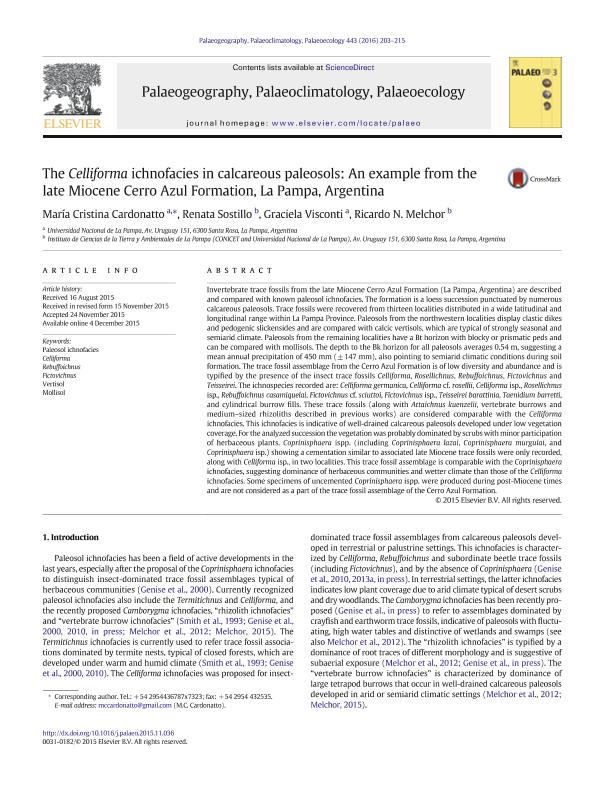Artículo
The Celliforma ichnofacies in calcareous paleosols: An example from the late Miocene Cerro Azul Formation, La Pampa, Argentina
Fecha de publicación:
02/2016
Editorial:
Elsevier Science
Revista:
Palaeogeography, Palaeoclimatology, Palaeoecology
ISSN:
0031-0182
Idioma:
Inglés
Tipo de recurso:
Artículo publicado
Clasificación temática:
Resumen
Invertebrate trace fossils from the late Miocene Cerro Azul Formation (La Pampa, Argentina) are described and compared with known paleosol ichnofacies. The formation is a loess succession punctuated by numerous calcareous paleosols. Trace fossils were recovered from thirteen localities distributed in a wide latitudinal and longitudinal range within La Pampa Province. Paleosols from the northwestern localities display clastic dikes and pedogenic slickensides and are compared with calcic vertisols, which are typical of strongly seasonal and semiarid climate. Paleosols from the remaining localities have a Bt horizon with blocky or prismatic peds and can be compared with mollisols. The depth to the Bk horizon for all paleosols averages 0.54 m, suggesting a mean annual precipitation of 450 mm (± 147 mm), also pointing to semiarid climatic conditions during soil formation. The trace fossil assemblage from the Cerro Azul Formation is of low diversity and abundance and is typified by the presence of the insect trace fossils Celliforma, Rosellichnus, Rebuffoichnus, Fictovichnus and Teisseirei. The ichnospecies recorded are: Celliforma germanica, Celliforma cf. rosellii, Celliforma isp., Rosellichnus isp., Rebuffoichnus casamiquelai, Fictovichnus cf. sciuttoi, Fictovichnus isp., Teisseirei barattinia, Taenidium barretti, and cylindrical burrow fills. These trace fossils (along with Attaichnus kuenzelii, vertebrate burrows and medium–sized rhizoliths described in previous works) are considered comparable with the Celliforma ichnofacies. This ichnofacies is indicative of well-drained calcareous paleosols developed under low vegetation coverage. For the analyzed succession the vegetation was probably dominated by scrubs with minor participation of herbaceous plants. Coprinisphaera ispp. (including Coprinisphaera lazai, Coprinisphaera murguiai, and Coprinisphaera isp.) showing a cementation similar to associated late Miocene trace fossils were only recorded, along with Celliforma isp., in two localities. This trace fossil assemblage is comparable with the Coprinisphaera ichnofacies, suggesting dominance of herbaceous communities and wetter climate than those of the Celliforma ichnofacies. Some specimens of uncemented Coprinisphaera ispp. were produced during post-Miocene times and are not considered as a part of the trace fossil assemblage of the Cerro Azul Formation.
Palabras clave:
Paleosol Ichnofacies
,
Celliforma
,
Rebuffoichnus
,
Fictovichnus
,
Vertisol
,
Mollisol
Archivos asociados
Licencia
Identificadores
Colecciones
Articulos(INCITAP)
Articulos de INST.D/CS D/L/TIERRA Y AMBIENTALES D/L/PAMPA
Articulos de INST.D/CS D/L/TIERRA Y AMBIENTALES D/L/PAMPA
Citación
Cardonatto, María Cristina; Sostillo, Renata; Visconti, Graciela; Melchor, Ricardo Nestor; The Celliforma ichnofacies in calcareous paleosols: An example from the late Miocene Cerro Azul Formation, La Pampa, Argentina; Elsevier Science; Palaeogeography, Palaeoclimatology, Palaeoecology; 443; 2-2016; 203-215
Compartir
Altmétricas




